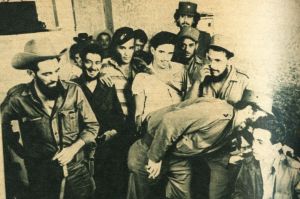 In August 1959, the Dominican tyrant Rafael L. Trujillo gave it all in his quest to destroy the Cuban Revolution led by Fidel Castro and suffered the greatest humiliation of his life. More than five decades have passed, but the historical three days of August 1959 will never be forgotten.
In August 1959, the Dominican tyrant Rafael L. Trujillo gave it all in his quest to destroy the Cuban Revolution led by Fidel Castro and suffered the greatest humiliation of his life. More than five decades have passed, but the historical three days of August 1959 will never be forgotten.
The tyrant of Quisqueya, also known as Chapitas for his disproportionate fondness to badges and medals, had a long list of pending businesses with the Revolutionary Government and his young leader Fidel Castro.
Trujillo’s hand not only drowned his homeland in blood for many years, but also kidnapped and killed his political opponents exiled in other countries, such as Professor Galindez, based in the United States, and Mauricio Baez and “Pipi” Hernandez, killed by his henchmen in Havana.
Once started the insurrection against Fulgencio Batista, especially from the very landing of the Granma Yacht, Chapitas forget his old quarrels with the dictator and sold weapons to help in his attempt to crush the burgeoning libertarian movement, but Batista was overthrown and Trujillo hosted him in Santo Domingo on the historic morning of January 1959.
CREATION OF THE WHITE ROSE
The links between Trujillism and the representatives of the Cuban oligarchy set already in the early months of 1959, soon spread to the Directorate of the II Frente Nacional del Escambray by commander William Morgan, CIA infiltrated agent in Cuba since 1957 .
While in Santo Domingo some figures such as former general Eleuterio Pedraza and gangster Policarpo Soler had the full support of Chapitas in their strategy against Cuba, an organized opposition, composed of politicians, wealthy people and military from the old regime, shaped in the island which with total disrespect to Jose Marti created the counterrevolutionary group La Rosa Blanca (The White Rose).
It is believed that one of the conspirators, encouraged by the defection of Pedro Luis Diaz Lanz, until then head of the Revolutionary Air Force (FAR), and supported by Mr. Ferrando, Dominican consul in Miami, proposed to American William Morgan to participate in the plot to overthrow Fidel.
Morgan told his boss, Eloy Gutierrez Menoyo, about the proposition, and the latter, perhaps fearing the consequences of the conspiracy if exposed, determined to advise the Commander in Chief. The leader of the Revolution decided to play along and start the infiltration of agents in the seditious movement.
From that time on preparations were accelerated. The American travels to Miami several times and there he meets Ferrando and interviews with other persons and establishes direct contacts with Trujillo.
THE TRAGICOMEDY IN MOTION
The plot got a national character and involved over 1 000 individuals. The plan demanded the simultaneous occupation of major military and economic centers of the country, the revolt of the rebel army garrisons and the bombing of the cities of Havana and Santiago de Cuba by aircraft based in Santo Domingo.
This was completed with the creation of a guerrilla front in the Escambray, whose mission was the rapid take of Trinidad and its airport, through which they would receive Dominican reinforcements sent by Chapitas, who had armed and trained a special body called the Caribbean Legion, consisting of 3 000 mercenaries from different sources.
Due to the magnitude and dangerousness of the opponent project, Fidel believed at the time he should abort and gave orders to arrest the conspirators present in Havana. Then, the rebel officers moved to Las Villas to capture the civilian and military conspirators in that province.
He immediately sent troops to the Trinidad area in order to simulate a situation of war in the city and its surroundings. This was done and the report sent to Quisqueya’s tyran said that “everything was well”. On August 12th, a C-46 airplane fromTrujillo with arms and supplies for the alleged rebels landed in Trinidad’s airport, while a staged comedy of Long Life toTrujillo and slogans against the Revolution took place.
On the night of August 14 Fidel appeared on television to inform the people about what had happened and to uncover the worst of the tyrants of the continent. For Trujillo, that was a colossal failure, a ridicule, and a political disaster, while the leader of the nascent Caribbean revolution emerged with redoubled prestige before his countrymen and the peoples of America.
Note: Chapitas was killed on May 30, 1961 on a suspected CIA involvement attack.
 Escambray ENGLISH EDITION
Escambray ENGLISH EDITION





Escambray reserves the right to publish comments.